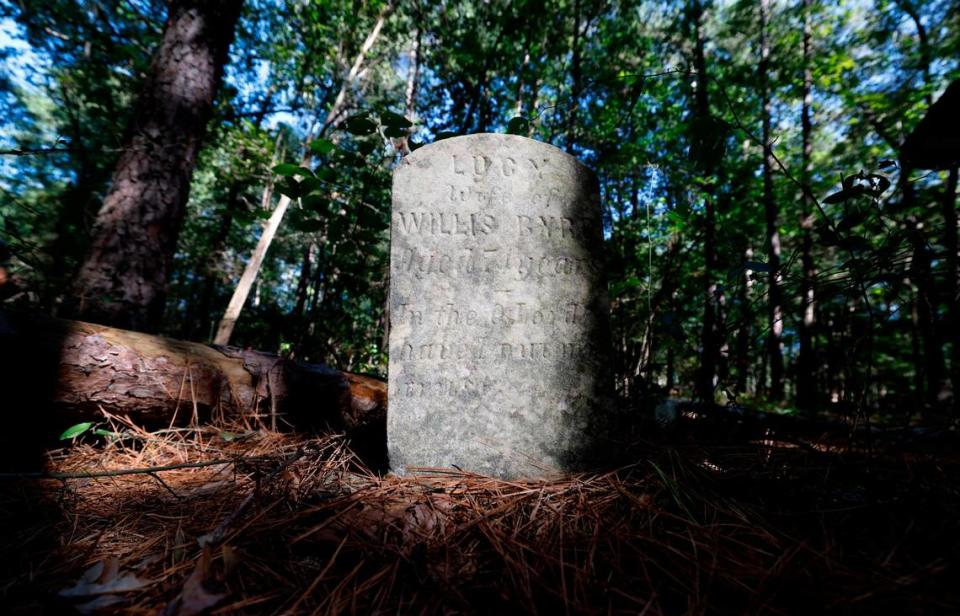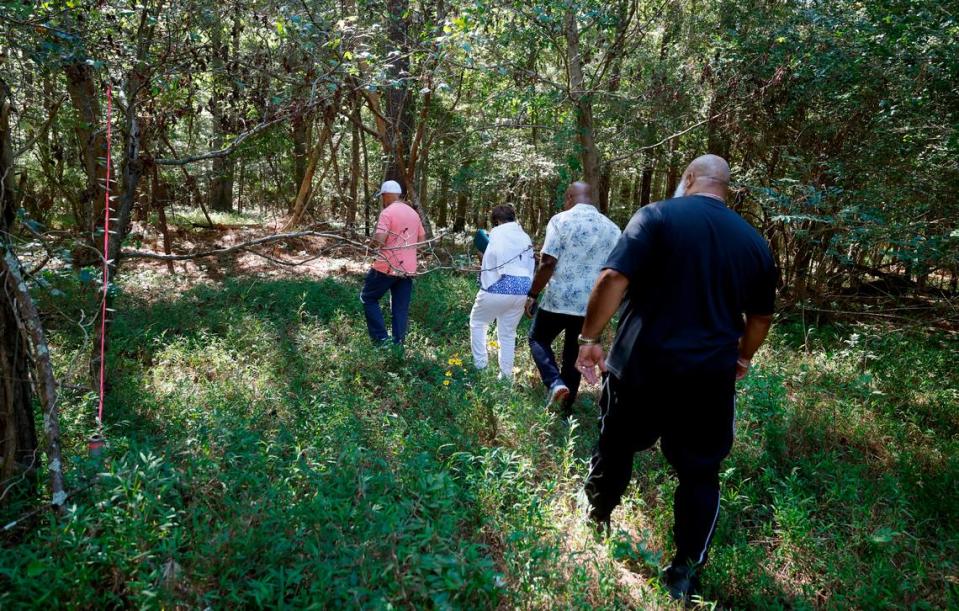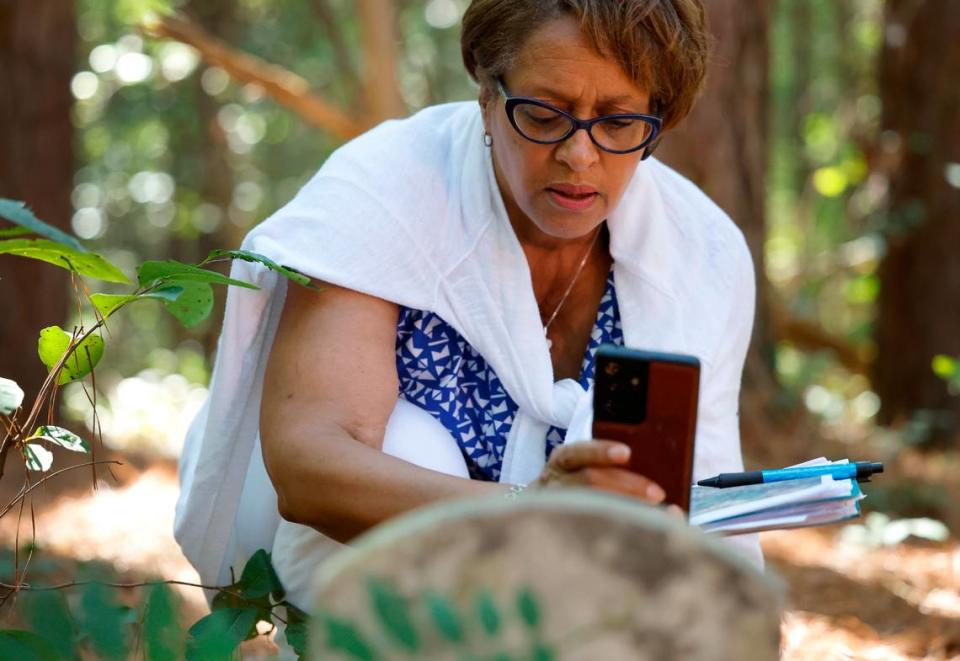‘To keep our footprint’: Family is on a mission to protect NC ancestors’ graves
When you’re part of a big family, like Glenn Evans is, you need someone to help watch over the family history.
Evans, a financial adviser and part-time genealogist, has planned reunions and written histories tracing his family’s roots in the South.
The Evans family are descendants of some of the first free African Americans to settle in the Wake and Chatham county areas. Part of his family owns the Turner-Evans Family Cemetery on Old Apex Road in Cary, where relatives have 12 streets and three subdivisions named after them.
A few months ago, a new challenge put Evans into overdrive.
A question from a local historian led him on a quest to protect more of his ancestors’ graves, including nearly 40 unmarked ones, in Byrd Chapel Cemetery in Chatham County. The cemetery is near the future VinFast electric car plant in the Triangle Innovation Point business park in Moncure. The road to get there will run alongside the graves.
“She asked me if I was aware of the development initiative that was taking place in Chatham County — and I wasn’t,” Evans said.
Tucked off New Elam Church Road, beneath fallen tree branches and scattered litter are the graves of Willis and Lucy Byrd and their daughter, Emeline Macklin. They were among the first free Black Americans who settled in Chatham County in the late 19th and 20th centuries.
Their graves are also the only three in the Byrd Chapel Cemetery with headstones.
Others, some now sunken into the earth, are marked with rocks and stones, old markers from past researchers, and covered by grass and leaves.
The cemetery was once attached to the Byrd AME Zion Church, which stood on the land now occupied by a brick house and mobile homes. Little is known about the congregation except that it likely included farmers, domestics, sharecroppers, and local Black leaders pre and post-enslavement.
Evans is descended from Lucy, his third great-aunt. His third great-grandfather is one of Lucy’s brothers, Fielding.
“My first concern was, do we know where all the bodies are buried? What are the risks of us inadvertently disturbing a gravesite?” Evans said. “The other concern was ... whether or not the road building would require the moving of the grave sites.”
To build the plant, VinFast and the state Department of Transportation will need roads. This includes clearing space beside New Elam Church Road and U.S. 1, next to the Byrd family cemetery, taking 27 houses, five businesses, and relocating a church in Moncure, less than a mile from the graveyard.
Evans said neither the state nor the company reached out to the descendants and relatives of the Byrd family about the graves or to provide any information about how they plan to project the area. So he set out to find the answers himself.

A changing rural county with a deep history
With the $4 billion VinFast project and the arrival of technology companies in southern Wake County, the mostly rural Moncure area in southern Chatham County will soon look very different.
The county was formed out of Orange County in 1771. A year before the Civil War began, one in three people there were enslaved African Americans, according to local historian Jim Wiggins.
After 1865, violence against free and newly freed Black Americans increased with the formation of the Ku Klux Klan. By the 20th century, the county had documented six lynchings of Black people. Sixteen-year-old Eugene Daniel was the last person to be lynched in 1921, five miles from Pittsboro.
Last July, Wiggins published a document detailing the lives of the free people of color in the county.
“Beginning in 1850, race was recorded for each household and the offered categories were white, Black, mulatto,” Wiggins wrote. “Chatham County census-takers made liberal use of the unclear distinction as a large majority of the free persons of color were identified as Mulatto. Only free, that is not enslaved, people of color were listed in the population census.”
In 1850, 47 homes in the county were headed by free people, Black and Mulatto, numbering 221 people. That increased by 1860, with 255 free people living in the county. Many mulatto people were the children of a white woman and a Black man, Wiggins noted, which often had repercussions due to laws against relationships between white and Black people, freed or enslaved. Other Mulatto people were the children of an enslaved woman and a white man, typically her owner.
Using wills, marriage and death records, Wiggins lists the names of several households headed by free people of color in 1850, including the names Byrd and Evans.
Granderson Evans, Lucy’s younger brother, was a farmer, furniture maker and delegate to the 1870 North Carolina State Republican Convention, along with Willis Byrd, a farmer, and George W. Macklin, chairman of the Republicans of Chatham County.
“When I was a kid, I visited Southern Pines on multiple occasions and was close to my grandmother’s side of the family but I actually knew very little about my grandfather’s side, my Evans side,” said Evans, a Harlem native. “Working hard was just a core value in my family. My dad pushed my sisters and myself pretty hard, and he was a hard-working man.”
Evans’ second great-grandfather, George, moved from Chatham to Moore County to operate a turpentine business making barrels. The Evans family passed down land, titles, wealth and values that reached the new generations of the family. Owning land was integral to the survival of the family.
“That was a seed corn that gave us mobility, that gave us a livelihood,” Evans said. “We were farmers for many, many generations. … It’s important that African Americans do things like document in a will how they expect to have their assets distributed because it sustains families over generations.”

‘You can’t buy memories’
In a survey by the Office of State Archaeology, researchers found the cemetery and former church were donated by Willis Byrd’s son Amos and his wife, Eliza, to the African American Methodist Episcopal Church in 1914. They believe Amos died in Durham in 1928, though no death certificate could be found.
After the property was transferred to the church, AME Zion trustees sold the land in 1992 to Rhonda Stone Mitchell and her husband, Daniel. In 1998, the land was transferred to Mitchell’s relative, Patty Shelton Stone, and her mother, Lena Stone.
The Stones, a white family, live in a one-level brick house and mobile homes in front of the cemetery on New Elam Church Road.
In a phone interview, Stone, 51, said she remembered playing in the abandoned church before her grandfather had the old building torn down.
“We knew some things about it but not much,” Stone said. “We always tried to keep the cemetery up but after years, some of the graves look like they’re falling in, some don’t have headstones, so it just sits there. We actually didn’t know just how many graves were back there.”
When the family learned about VinFast, they grew concerned for the fate of the only homes they had ever known.
“Just about all our family grew up around here,” Stone said. “No matter what they pay you, you can’t buy memories.”
None of the Stones’ relatives are buried in the Byrd Family Cemetery. When asked if her mother would consider selling the land to the Evans family, Stone said she doesn’t think so.
“I’m pretty sure my mom is not going to sell. She said (the family) can come and visit and have access to it, but beyond that, it’s only an acre. If it was more, we would really consider it.”
The Byrd and Evans families have faced threats to their ancestors’ graves before.
In 2008, Prenetta Evans, a cousin of Glenn, watched a three-man construction crew tear down trees on her property in Cary and unearth her baby’s remains with a backhoe. The baby had died a week after she was born in 1974. Evans and her husband couldn’t afford a proper funeral, so they wrapped their baby in a blanket, placed her in a box, and buried her in their yard.
Even though residents along Evans Road, then a dirt path off N.C. 54, fought the project, the town of Cary used eminent domain to take part of the property for a $6.4 million road widening project. Evans Road now connects Cary and Morrisville. The project affected 55 properties.
The family believes that because of a loss of communication and connection, no one in the extended Byrd-Evans family owns the land where the cemetery is located.
Donald Evans Sr., another of Glenn’s cousins, said the family’s main goal is to “preserve and maintain the Byrd-Evans family legacy, not only for this generation but for future generations to come.”
“Not having the ability to freely own, access, and preserve the permanent resting place of our ancestors with the sanctity and sacredness we desire is a form of bondage. We must be allowed to own and preserve this hallowed ground for the Byrd-Evans family,” Donald said.
Chatham County property records show the land where the 0.4-acre cemetery and Stone’s home are located is valued at $62,047.
‘Bad things can happen’
Aaron Moody, a spokesperson for NCDOT, said Byrd Chapel Cemetery is outside of the VinFast project limits. The closest cemetery edge would be about 52 feet from the proposed road widening on New Elam Church Road and the actual edge of service would “be about another 15 feet farther away.”
“We always work to identify the path that has the fewest impacts on people, properties and the environment,” Moody said in an email to The News & Observer. “In some cases, this is unavoidable. Decisions are made balancing criteria such as safety, impacts to the natural and human environment, costs, and traffic service.”
Still, Evans said the family remains apprehensive.
According to state archaeologists, Byrd Chapel Cemetery was active throughout the 19th and 20th centuries but lacks the qualifications to be listed on the National Register of Historic Places. That means there are no state or federal protections available for the cemetery.
“Despite the long history of the Byrd family as free African Americans beginning in the eighteenth (1700s) century, research does not indicate that the family were persons of transcendent national, regional, or local importance or that the cemetery is associated with events of historical significance,” the study reads.
The cemetery was first recorded in 1992 by Gertha Clark and was last surveyed in 2006, when 43 graves, including the three marked ones, were found there.
Beverly Wiggins, a volunteer with the Chatham County Historical Association, helped survey the cemetery in 2006.
When she learned about VinFast’s plans, she asked the state for records of all the cemeteries in Chatham County. The Byrd Chapel Cemetery was listed but without a full report.
“That flagged for me that there was some reason for somebody to look at that cemetery,” she said. “That made me be concerned that the road was the reason. Since then, we’ve been trying to get additional information.”
The Historical Association usually learns of gravesites through word of mouth, hunters or new property owners.
Volunteers try to count any graves they can identify and mark them. To date, some 600 graves have been found across Chatham County.
“In early cemeteries, man-made stones, markers were not common so a lot of graves are marked with fieldstones, a rock at the head and a rock at the foot,” Wiggins said. “The new technology is the ground-penetrating radar, but it doesn’t always work, especially in overgrown sites like the Byrd Chapel Cemetery.”
Wiggins believes it is important “for people to not accidentally destroy something that shouldn’t be destroyed.”
“When people were buried, their families meant for them to stay there,” she said. “That should be respected. And for people doing genealogy, sometimes what is written on a headstone might be the only information available to them.

‘Keep our footprint’
On a sunny, humid afternoon in September, cars filled the parking lot outside Mt. Zion Baptist Church in Apex. Evans and his family were in the Triangle for their family reunion, but before it began, eight relatives wanted to see what they called the Byrd Family Cemetery.
After the nearly 20-minute drive, they parked along New Elam Church Road and in the shaded property of the Stone’s homes to walk through the woods to the graves.
“We’re on sacred ground,” said Valarie Frasier, a cousin and real estate agent. She crouched in front of the three tombstones to get a better look at the markers, while Larry Harris, a descendant of Granderson Evans, examined the bricks left in the grass, possibly belonging to the old church.
The only headstone with a date was Willis Byrd’s of 1904, the year he died at 91.
Little is known about when Lucy died but the couple’s daughter, Emeline, died in 1940 at 105 years old, according to U.S. Census records.
The family fell quiet, lost to thoughts of their ancestors, once a thriving community of freed people, their remains now lying beneath trash, pine needles and overgrown bushes. A cellar spider sat on Lucy’s headstone.
Sunlight peaked through the towering oaks and long-leaf pines, offering just enough light to read the faded writing on the headstones.
“Can I ask if we say a prayer?” Evans asked, grabbing the hands of his family. “Lord, Jesus, we thank you for this wonderful day and for bringing us out here to visit our ancestors.”
The last time some of the descendants had visited the graves was in 2007.
“We have so many communities that are now completely gone, and folks are walking around on ground that they know nothing about,” Frasier said.
The visit inspired the family to take action. They talked about fencing the area and getting a marker, and about keeping the site clean throughout the year. Frasier wondered what it would take to move the three ancestors buried with headstones to the Turner-Evans cemetery in Cary.
They made no decisions that day but vowed to stay ahead of whatever might come next.
“We’re trying to keep our footprint here,” Harris said. “That’s all this is.”

